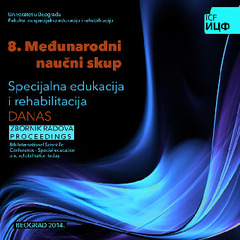Приказ основних података о документу
Specifičnosti tretmana starih osoba u zatvoru
Specifically treatment of the olden in prison
| dc.contributor | Vuković, Mile | |
| dc.contributor | Kovačević, Jasmina | |
| dc.contributor | Maćešić-Petrović, Dragana | |
| dc.creator | Jovanić, Goran | |
| dc.date.accessioned | 2022-03-22T13:14:16Z | |
| dc.date.available | 2022-03-22T13:14:16Z | |
| dc.date.issued | 2014 | |
| dc.identifier.isbn | 978-86-6203-061-0 | |
| dc.identifier.uri | http://rfasper.fasper.bg.ac.rs/handle/123456789/4258 | |
| dc.description.abstract | Zatvori su dizajnirani za mlađe osuđenike i nisu prilagođeni za starije sa različitim i specijalnim potrebama. Stepenice, gužva i arhitektonske barijere stvaraju dodatne probleme za boravak starih u zatvoru. Potrebna im je i posebna medicinska briga, poput posebne dijete za ishranu. Usled ubrzanih promena tokom starenja, neophodni su redovni pregledi vizuelnih, auditivnih i drugih modaliteta funkcionisanja. Preporučuju se aktivnosti koje održavaju osuđenike zdravim i poboljšavaju njihov kvalitet života.Starenje se može definisati kao zbir svih procesa koji se kod pojedinca zbivaju od datuma rođenja kroz ceo tok njegovog života. Iako nema konkretne hronološke granice kada se ljudi smatraju starima, gerontolozi grupišu ljude u tri kategorije: osobe preko 55 godina spadaju u „staru populaciju“, one preko 65 godina u „stariju populaciju“ dok se osobe sa 85 godina i više svrstavaju u „najstariju populaciju“. Neke promene nastale usled starenja posebno pogađaju osuđene kao: smanjenje interakcije, povećan strah od umiranja, briga zbog bola, bespomoćnosti i održavanja u životu pomoću aparata, strah od smrti bližnjih, kolega, prijatelja, smanjenje fizičke snage i izdržljivosti, gubitak nezavisnosti zbog nesposobnosti kretanja. Studije pokazuju da se stariji osuđenici mogu kategorisati u najmanje tri grupe zasnovane na njihovoj kriminalnoj istoriji. Prva grupa su oni koji su priznali svoj zločin sa 50 i više godina starosti, osuđeni na zatvor po prvi put. Druga grupa starih osuđenih uključuje karijeru ili kriminalce po navici koji ulaze i izlaze iz zatvora godinama u toku svog života. Treća grupa su oni koji su služili duge kazne od mladih dana i imaju dugu istoriju u zatvorskom sistemu. Primarni problem je njihovo smeštanje u posebne prostore, dizajnirane prema njihovim potrebama. Povećanjem prosečne starosti opšte populacije, može se očekivati i veći broj starih lica u zatvorima. | sr |
| dc.description.abstract | Prisons are designed for younger prisoners and they are not adapted for elderly with diverse and specific needs. Stairs, crowd and architectural barriers create additional problems for residence of elderly in prison. This population requires special medical care, such as special diets. Since rapid changes are occurring during the ageing, regular exams of visual, auditive and other modalities of functioning are necessary. Activities that sustain and improve healthy quality of life in prisoners are recommended. Aging can be defined as a set processes which occur from the birth through the entire life course. Although there is not any chronological boundaries that define older population, gerontologists separates people in three categories: people over 55 years are called “Elderly“, those who are over 65 years are categorized as “Young-old“, while persons over 85 years are referred as the “Oldest-old“. Some changes that occur during ageing especially target prisoners and those changes are: decrease of social interaction, increased fear of dying, worry for pain, helplessness and maintenance of life with devices, fear of death of loved ones and colleges, reduction of physical strength and endurance, loss of independence because of the inability to move. Studies show that older prisoners can be categorized in at least 3 groups based on their criminal history. The first group has admitted their crime while they had 50 or more years, and that is their first conviction. The second group has a criminal career and they are convicted for prison sentences many times during their life. The third group are those who are convicted in their youth and have a long time sentence in prison. The primary issue is their residency in special rooms, that are designed according to their special needs. With the increase of average number of elderly in general population, we can expect that larger number of elderly in prisons. | sr |
| dc.language.iso | sr | sr |
| dc.publisher | Univerzitet u Beogradu – Fakultet za specijalnu edukaciju i rehabilitaciju/ University of Belgrade – Faculty of Special Education and Rehabilitation | sr |
| dc.rights | openAccess | sr |
| dc.rights.uri | https://creativecommons.org/licenses/by-sa/4.0/ | |
| dc.source | Zbornik radova - 8. Međunarodni naučni skup „Specijalna edukacija i rehabilitacija danas“, Beograd, Srbija, 7-9. 11. 2014 | sr |
| dc.subject | tretman | sr |
| dc.subject | osuđeni | sr |
| dc.subject | stari | sr |
| dc.subject | zatvor | sr |
| dc.subject | treatment | sr |
| dc.subject | prisoners | sr |
| dc.subject | olden | sr |
| dc.subject | prison | sr |
| dc.title | Specifičnosti tretmana starih osoba u zatvoru | sr |
| dc.title | Specifically treatment of the olden in prison | sr |
| dc.type | conferenceObject | sr |
| dc.rights.license | BY-SA | sr |
| dc.citation.epage | 232 | |
| dc.citation.spage | 227 | |
| dc.identifier.fulltext | http://rfasper.fasper.bg.ac.rs/bitstream/id/6683/Untitled25.pdf | |
| dc.identifier.rcub | https://hdl.handle.net/21.15107/rcub_rfasper_4258 | |
| dc.type.version | publishedVersion | sr |


